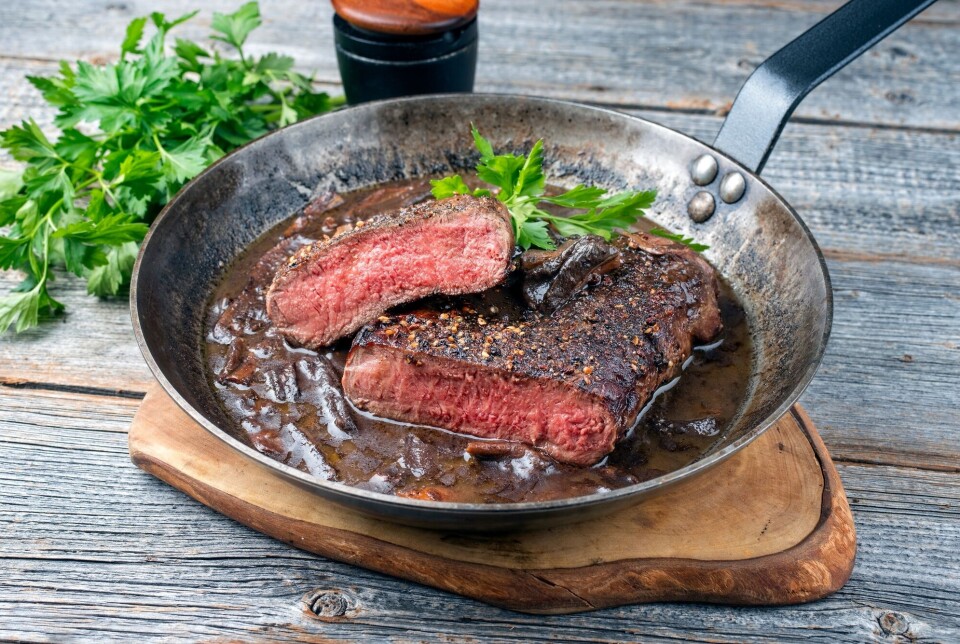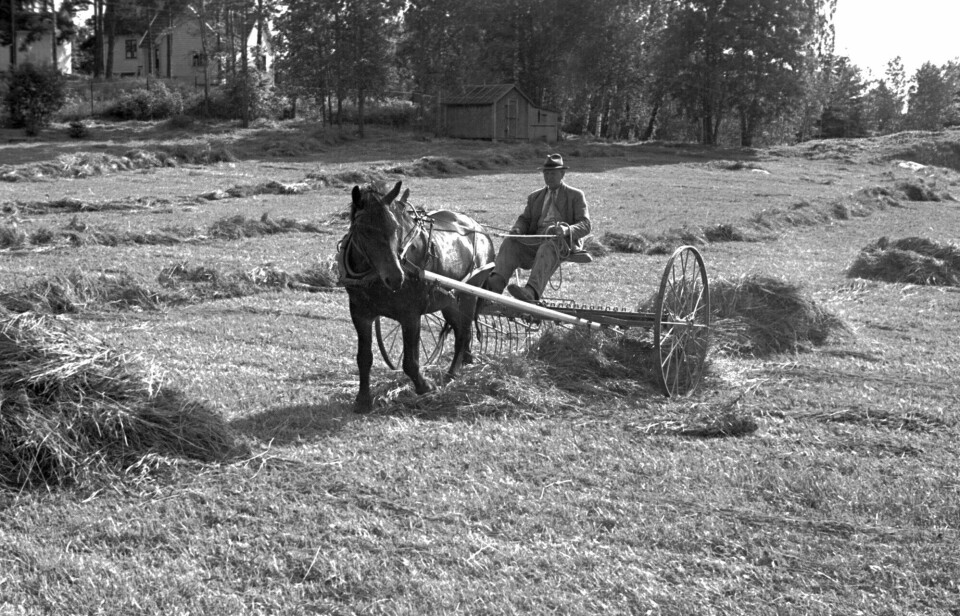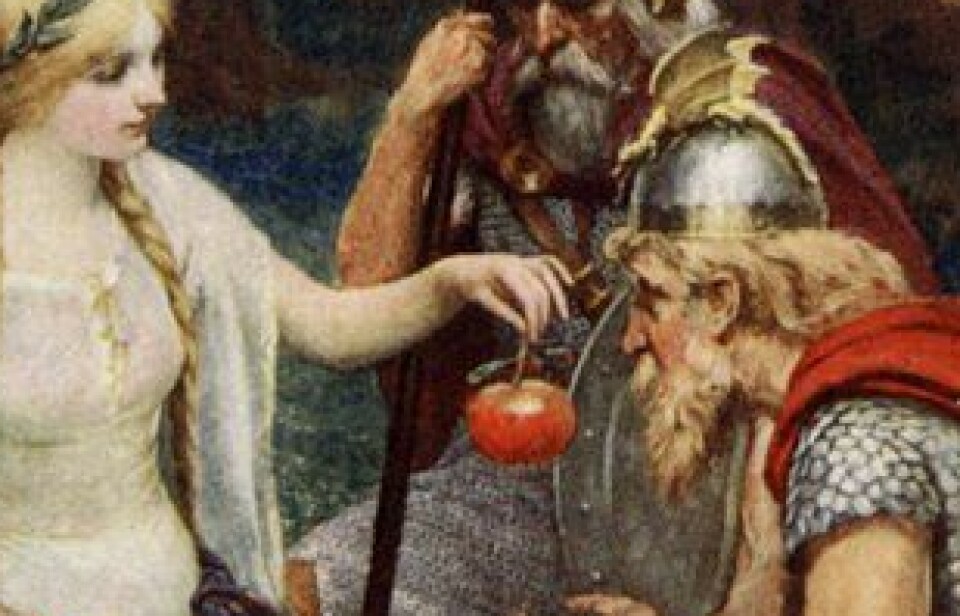
Horse meat was banned over 1,000 years ago, but that did not keep people from eating it
And yet, the prejudices still remain.
Christianity came to Norway around the year 1000, and it brought with it numerous dietary rules.
It was obligatory to have meat-free days, to eat fish on Fridays, and to fast before Christmas and Easter. The Catholic Church thus exerted a major influence on what people ate.
Eating horse meat was forbidden.
But did people obey these rules? Did they stop eating horse meat?
Horse meat was considered the food of heathens
Horses were important in pre-Christian times. Their remains are found everywhere in excavations from the Viking Age – on jewellery, rune stones, in graves and at sacrificial sites.
The findings suggest that the Vikings slaughtered horses as sacrifices to the gods and then ate them.
It might have been the horse's important role in the old religion that caused the Catholic Church to forbid the eating of horse meat.
A meeting between the Christian King Haakon the Good and heathen farmers in Trondheim gives us an idea how important horse meat was.
The king absolutely refused to eat horse meat when it was served. The peasants insisted, the king refused. They asked him to drink the broth or eat the fat from the horse soup, but the king didn't want to do that either, according to norgeshistorie.no (link in Norwegian).
Most viewed
Finally, the king agreed to put his mouth over the handle of the pot, which was greasy from the steam from the soup. But Haakon put a linen cloth over the handle before he touched his mouth to it. The peasants were not satisfied.
Eventually the Christians won control over the country and banned horse meat. However, people appear to have continued eating it nonetheless.
Horse bones in every town
Anne Karin Hufthammer has analysed bones from large excavations in four Norwegian cities: Oslo, Tønsberg, Bergen, and Trondheim. She is a recently retired professor of osteology – which is the study of bones and skeletons – from the University of Bergen.
“We find horse bones in every single city,” she says.
Hufthammer has looked at several thousand bones from the Middle Ages.
“We can see traces of knives having been used,” she says.
A dead horse contains a lot of meat. The hide was used for various purposes, and marks from axes and knives indicate where it was skinned.
“We also see knife marks that show the body has been cut into smaller pieces and that the meat has been sliced off. This indicates that people used the meat for food, probably for humans,” Hufthammer says.
Even at the Archbishop's Palace
Another possibility is that the horse was cut up to bury it, but Hufthammer does not think so.
“The horse bones were mixed in with household waste, along with bones from cattle, sheep, pigs, and other animals they ate,” Hufthammer says.
Admittedly, there are fewer bones from horses than from cattle, goats and sheep.
“This is because horses weren’t bred for food, but for transport and as draft animals. But once a horse was slaughtered, people chose to use the meat rather than let it go to waste," she believes.
Hufthammer’s research includes studying 12 excavations from medieval Oslo.
“Sometimes we find lots of horse bones in the rubbish heap, other times not so many,” she says.
Even at the Archbishop's Palace in Trondheim, archaeologists discovered remains of the animal that was forbidden to eat.

“Admittedly, there weren't as many horse bones there as elsewhere, but these also had chopping and cutting marks. We don't know who ate horse meat on the premises, whether it was the archbishop or the servants,” Hufthammer says.
More horse with Martin Luther
The researchers have not yet analysed the age of the bones, beyond the fact that they were found in the Middle Ages, which spans many years.
“We will date them eventually. Then we can perhaps also say something about whether there was more or less consumption of horse meat throughout the Middle Ages,” Hufthammer says.
Horses were not the only animals that were forbidden to eat in the Middle Ages. Eating dogs and cats was also banned. But this ban does not appear to have been adhered to either. Hufthammer has found clear signs of butchering for food on dog bones in Bergen. Cats, however, were skinned but not butchered.
The consumption of horse meat increased with the advent of Protestantism and the declining influence of the church.
Horses were still not bred for human consumption, but it was considered good use of the animal to eat it after its work in the filds was done.
But the old prejudices still lingered.
Stupid, old prejudices
One reader of the former labour party newspaper Arbeiderbladet wrote in 1952 that an information campaign should be required to teach people to eat horse meat. At that time, Oslo only had one outlet for horse meat.
“We have to get rid of stupid, old prejudices against horse meat,” the director of Meat and Pork Central told the former daily newspaper Hamar Stiftstidende the same year.
As tractors became more common through the 1950s, horse numbers declined. They were used more for harness racing and hobby riding.

With fewer horses, there was less horse steak.
In 1953, 9,000 horses were slaughtered for food. Now, fewer than 100 are slaughtered, according to Statistics Norway.
The Eidsmo Dullum slaughterhouse in Trøndelag county slaughters horses for human consumption.
Kalus Arild Sandøy says that they take in 60 to 70 horses a year.
“We reject a lot of horses. The owners have to submit a horse passport and health card, and then these need to be checked by a veterinarian,” he says.
Too much medication
Many horses offered to the slaughterhouse have been treated with too many medications to be fit for human consumption, lack a health card, or have an unknown origin from abroad.
“We’re strict when it comes to slaughtering animals for food. That frustrates a lot of owners,” Sandøy says.
From the slaughterhouse, the horse meat goes on to the food industry. The Norwegian meat processing company Gilde has three cured sausages with some horse meat in addition to pork. The best cuts of meat go to restaurants and butcher shops.
It is also possible to buy horse meat at Strøm-Larsen, a meat wholesaler in Oslo. Although horse tenderloins are far cheaper than beef, they do not sell much of it.
“We experience some demand, but it’s difficult to get a hold of horse meat,” Heidi Strøm-Larsen says.
Famous chefs like Ingrid Espelid Hovig, Andreas Viestad and Eivind Hellstrøm have recommended horse steak, according to the Norwegian tabloid VG (links in Norwegian). The meat is said to be tender, sweet, and tasty.
Hufthammer agrees. She has eaten horse meat at a restaurant in Italy, where horse meat is far more common than in Norway.
“It was good meat and tasted a bit like moose, I think,” she says.
———
Translated by Ingrid P. Nuse
Read the Norwegian version of this article at forskning.no






































